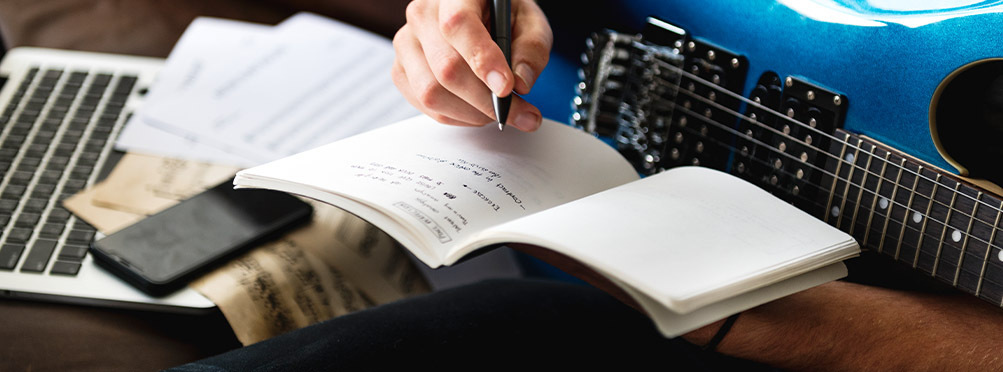E minor pentatonic is one of the most beginner-friendly guitar scales that forms the basis for countless genres’ riffs, solos, and improvisations. It is one of the most basic scales, but mastering it will give you a whole new world when playing music and understanding how it functions, whether for beginners progressing to intermediate. Apply this scale to your playing today!
At Artium Academy, we believe practising this guitar technique will open the doors to creative riffs, compelling solos, and improvisational capabilities. This blog will address basic guitar techniques that’ll help you own the E Minor Pentatonic Scale.
But before that…
If you’re really excited to learn guitar, start with a free trial lesson today!
Understanding the E Minor Pentatonic Scale is Key to Your Guitar Playing
Mastering the e-minor scale can elevate your ability to play and be your ticket to a lifetime of guitar playing.
The E minor pentatonic scale comprises five notes: E, G, A, B and D. As the name states, it is pretty simple because you only have to remember 5 notes, unlike the traditional major or minor, which has seven!
These five notes make up the backbone of thousands of songs in genres like rock, blues, and jazz. This scale, when played, sounds emotive and versatile enough to be the first choice for guitarists around the globe.
The structure of the E Minor Pentatonic Scale is constructed as follows:
- E (Root)
- G (Minor Third)
- A (Fourth)
- B (Fifth)
- D (Minor Seventh)
Compared to the major scale, the pentatonic scale excludes the second and sixth notes, making it more straightforward to learn and play.
Learning to Play the E Minor Pentatonic Scale on the Guitar is a Fundamental Skill
The E Minor Pentatonic Scale is one of the most versatile and widely used scales when playing the guitar. Here’s how to get started with it:
Position Your Hand:
Place your index finger on the 12th fret of the low E string (the thickest string). This is the root note – E.
Play the Notes:
- Low E String: 12th fret (E), 15th fret (G)
- A String: 12th fret (A), 14th fret (B)
- D String: 12th fret (D), 14th fret (E)
- G String: 12th fret (G), 14th fret (A)
- B String: 12th fret (B), 15th fret (D)
- High E String: 12th fret (E), 15th fret (G)
Practice moving this pattern across the fretboard to explore other positions and shapes of the E Minor pentatonic scale. This will help you visualise the scale in different areas of the neck. Familiarise yourself with the pattern visually on the fretboard. Practising it slowly and accurately is crucial before gradually increasing your speed.
As part of our online guitar course, we offer detailed diagrams and instructional videos to make mastering this scale straightforward and enjoyable.
Guitar Practise Tips for Mastering the E Minor Pentatonic Scale
- Use a Metronome: Practising with a metronome sharpens your timing and precision. Begin slowly to ensure accuracy, then gradually increase the speed.
- Practice with Backing Tracks: Playing with backing tracks lets you hear how the scale complements chord progressions, boosting your improvisation ability.
- Break It Down: Master one position of the scale at a time. Once comfortable, connect these positions across the fretboard for seamless play.
- Apply Techniques: Add expression to your playing by integrating guitar techniques like slides, hammer-ons, pull-offs, and bends to make your notes more dynamic and engaging.
Incorporating the E Minor Pentatonic Scale into Your Playing Style
Once you understand the basics of this scale, it’s time to explore its creative potential. Here’s how to take your playing to the next level:
Creative Ways to Use the E Minor Pentatonic Scale
- Crafting Solos:
- The E Minor Pentatonic Scale is the backbone of many legendary solos in rock and blues.
- Experiment with guitar techniques like vibrato, string bending, hammer-ons, and pull-offs to add expression and flair.
- Blend your ideas with rhythms and notes by incorporating different guitar practice tips to develop your unique solos.
- Improvisation:
- Play over a backing track in E minor and let the music guide you.
- The scale’s simplicity makes it perfect for exploring and discovering new melodic ideas.
- Creating Riffs:
- Use the scale’s notes to compose memorable riffs that form the foundation of songs.
- Experiment with patterns and rhythmic variations to craft stand-out riffs.
The E Minor pentatonic scale is more than just a collection of notes—it’s a gateway to endless musical possibilities.
Common Mistakes to Avoid When Learning the E Minor Pentatonic Scale
Improper Finger Placement:
- The Issue: Fingers not pressing the strings correctly can result in muted or buzzing notes.
- Solution: Place your fingers just behind the frets, not directly on top or too far back, for a clean and precise sound.
Skipping the Metronome:
- The Issue: Practising without a metronome can lead to uneven timing and rhythm.
- Solution: Use a metronome to develop a consistent sense of timing and tempo as a guitar practice tip. Start slow and gradually increase the speed.
Rushing Through Practice:
- The Issue: Moving too quickly through positions prevents you from truly mastering the scale.
- Solution: Slow down! Focus on accuracy and muscle memory before picking up speed.
Neglecting Dynamics:
- The Issue: Playing all notes at the same volume can make your music sound monotonous.
- Solution: Experiment with dynamics, alternating between soft and loud notes to add emotion and variety to your playing.
Conclusion
E minor pentatonic is an empowering guitar scale. It’s more than just notes – it helps you craft solos, improvise, or compose solos, thus offering endless possibilities for expression and creativity. At Artium Academy, we emphasize the importance of mastering this scale and other guitar techniques that can elevate your playing and overall understanding of the instrument. Designed and certified by renowned Bollywood composer, Mr. Raju Singh, our online guitar lessons and classes can help you reach your absolute potential. Our course will not only help you master the technical aspects of playing guitar but also channel your inner musical talent.
Join a global music community of over 25,000 learners. Begin your online guitar classes today.
















